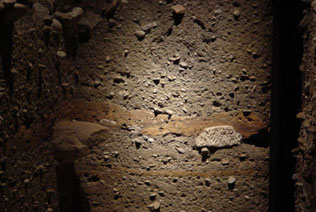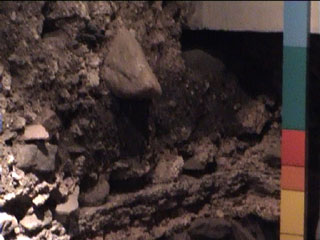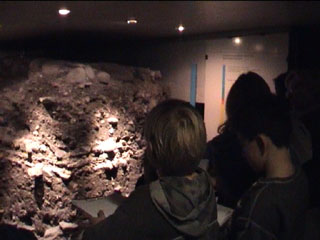How do archaeologists work?
|
Archeological
excavation has been going on under Saint Peter's Cathedral in Geneva
since 1976. Eleven excavation zones have become one of the most important
archeological sites north of the Alps. This piece of land has been a
center for Christian worship since 350 AD, but was inhabited long before.
|
||||||||||||||||||||||||
|
Dating
with stratigraphy
|
||||||||||||||||||||||||
 |
||||||||||||||||||||||||
| Use the controls to play this QuickTime Movie about stratigraphy | ||||||||||||||||||||||||
|
Under
the nave of the present Cathedral archaeologists are exploring more
than 42 layers in a depth of 2 meters, which span more than 2000 years
of human habitation. An illustration at a section of the Site describes
the strata shown:
|
||||||||||||||||||||||||

|
|
|||||||||||||||||||||||
 |
||||||||||||||||||||||||
|
|
||||||||||||||||||||||||
|
|
See a QuickTime movie to find out more about this area of the archaeological site. Click here to see students in the class sketching archaeological blocks.(There is no sound in this movie) |
|||||||||||||||||||||||
|
|
||||||||||||||||||||||||
|
Click here to learn more about the archaeological process at http://www.pastperfect.org.uk/archaeology/index.html |
Click here to learn more about dendrochronology at http://www.sonic.net/bristlecone/dendro.html |
To see the QuickTime movies on this page, you must have QuickTime Player installed on your computer. Click on here to go to the QuickTime web page and download QuickTime Player. |
||||||||||||||||||||||
|
Who
pays for archaeology?
|
||
| Archaeology studies the period from prehistory to the Industrial Revolution. In our area, that is 14,000 years of human activity! The care and conservation of artifacts in Switzerland is the domain of Cantonal museums. The Canton Departments of Archeology, on the other hand, manage ruins which cannot be housed in a museum. As an example, there are about 1800 known archaeological sites in the Canton of Vaud; of these few are visible.(There are 22 Cantons in Switzerland). | ||
| The excavations and development of the Archaeological Site under the Cathedral in Geneva were begun in 1976 under the auspices of the Canton Archeological Service. Private funding was sought, and the Foundation of the Keys of St. Peter's was established when the vastness of the site came to light. | Vaud includes some money in its budget for archaeological explorations and studies carried out either by the Canton itself for delegated agencies. Construction of autoroutes (multi-lane highways) permitted the discovery of the Lausanne-Vidy site, the Roman Villa at Orbe-Boscéaz, and the vast cemetery at Avenches. Archeodunum.S.A. (a private company)has excavated Onnens before the building of Highway A5, and the cemetery at Avenches before the construction of the Highway A1 | |
| Because it lay in the path of a new train track, the CFF (Swiss National Railway) financed the excavation of prehistoricvillages at Concise, although the dig was actually carried out by the Vaud Canton Archaeologist's Office. | Sites found in the course of large constructions projects are the responsibility of the Swiss Confederation, because the law stipulates that the those financing large projects are also responsible for funding. | |
|
the
Rhone River
|
This page was updated on 8 April, 2004 by K. Epps
Unless
otherwise mentioned, all photos are by Katharine Epps.
Sauf mention contraire les photos sont de Katharine Epps
nyon@isg-online.org